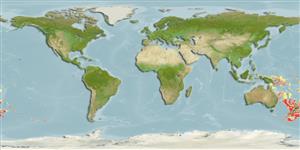Holocéphales (chimères) (chimaeras) >
Chimaeriformes (Chimaeras) >
Chimaeridae (Shortnose chimaeras or ratfishes)
Etymology: Hydrolagus: hydro-, combining form of hydor (Gr.), water; lagos (Gr.), hare, i.e., “water rabbit,” probably referring to three pairs of tooth plates, which tend to protrude from the mouth like a rabbit’s incisors. (See ETYFish); trolli: In honor of American artist Ray Troll (b. 1954), Ketchikan, Alaska (USA), “one of the few true chimaeroid lovers of the world ... for his valiant efforts to increase ratfish awareness worldwide”. (See ETYFish).
Environment: milieu / climate zone / depth range / distribution range
Écologie
marin bathydémersal; profondeur 612 - 1707 m (Ref. 45071). Deep-water
Western Pacific: New Caledonia and New Zealand.
Taille / Poids / Âge
Maturity: Lm ? range ? - ? cm
Max length : 112 cm TL mâle / non sexé; (Ref. 45071); 120.4 cm TL (female); poids max. publié: 8.8 kg (Ref. 122636)
Description synthétique
Morphologie | Morphométrie
Body blue-gray with a dark line around the orbit and dark shadowing along edges of lateral-line canals. Snout pointed. Preopercular and oral lateral-line canals sharing a common branch. D1 concave with pale margin. Males with frontal tenaculum deeply curved, upturned distally with spines along dorsal upturned edge. Prepelvic tenacula deeply indented along distal margin. Pelvic claspers with pale fleshy distal lobes, divided distally for 1/3 their length, tips usually extending beyond distal edge of pelvic fins. Ventral caudal fin not deeply indented at its origin to form a separate anal fin.
Oviparous (Ref. 205). Eggs are encased in horny shells (Ref. 205). Reported sexual maturity at 550-65.0 cm BDL or body length (Ref. 116866).
Life cycle and mating behavior
Maturité | Reproduction | Frai | Œufs | Fécondité | Larves
Didier, D.A. and B. Séret, 2002. Chimaeroid fishes of New Caledonia with description of a new species of Hydrolagus (Chondrichthyes, Holocephali). Cybium 26(3):225-233. (Ref. 45071)
Statut dans la liste rouge de l'IUCN (Ref. 130435)
Menace pour l'homme
Harmless
Utilisations par l'homme
Plus d'informations
RéférencesAquacultureProfil d'aquacultureSouchesGénétiqueElectrophoresesHéritabilitéPathologiesTraitementNutrientsMass conversion
CollaborateursImagesStamps, Coins Misc.SonsCiguateraVitesseType de nageSurface branchialeOtolithesCerveauxVision
Outils
Articles particuliers
Télécharger en XML
Sources Internet
Estimates based on models
Preferred temperature (Ref.
123201): 3.4 - 6.9, mean 4.8 °C (based on 322 cells).
Phylogenetic diversity index (Ref.
82804): PD
50 = 0.5000 [Uniqueness, from 0.5 = low to 2.0 = high].
Bayesian length-weight: a=0.00282 (0.00118 - 0.00673), b=3.10 (2.89 - 3.31), in cm total length, based on LWR estimates for this (Sub)family-body shape (Ref.
93245).
Niveau trophique (Ref.
69278): 4.0 ±0.6 se; based on size and trophs of closest relatives
Résilience (Ref.
120179): Faible, temps minimum de doublement de population : 4,5 à 14 années (Assuming Fec <100).
Fishing Vulnerability (Ref.
59153): High to very high vulnerability (72 of 100).
